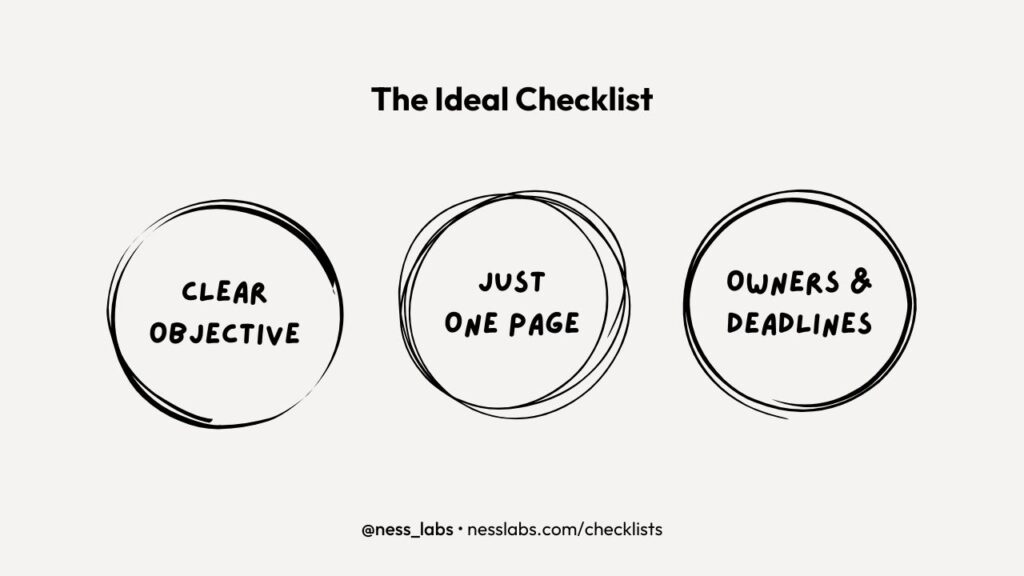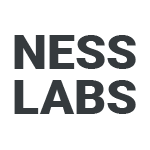From product launches to project management, I’m obsessed with checklists. And I’m not the only one.
Systemic complexity means that we cannot rely on our memory alone to know what to do and when to know it. Checklists are a powerful tool allowing us to unload some of the cognitive stress of living our lives to an outside helper.
That’s why they’re everywhere, from the World Health Organization’s surgical safety checklist to flight checklists and more mundane event production checklists. We use them to do our groceries, run businesses, and perform complex surgery.
Let’s explore the fascinating history of checklists and learn how you can design you own to unlock efficiency, precision, and – perhaps most importantly – peace of mind in your personal and professional projects.
Avoiding terrible mistakes
There’s no doubt that doctors and astronauts are smart. Yet, they rely heavily on checklists in their day-to-day work. No matter how much expertise we accumulate, we are still human. We are vulnerable to basic errors. And checklists can protect ourselves from some of the most blatant ones.
In 2018, hours into a brain surgery, Kenyan doctors realized there was no blood clot in the brain of their patient. They were operating on the wrong man. People on social media expressed shock at the horrifying mix-up, which could have been prevented by simply checking the patient’s identification tag.
This simple task is part of the World Health Organization’s surgical safety checklist, a 19-item list which aims at preventing the kind of frightening error that was made during the Kenyan’s man surgery. Its development was led by American surgeon and public-health researcher Atul Gawande.
It lists simple but essential items to review over the course of the three stages of a surgery, such as “confirm the patient identity”, “confirm the patient’s procedure and where the incision will be made”, or “confirm any known allergies”.
“It somehow feels beneath us to use a checklist, an embarrassment,” says Atul Gawande in his book The Checklist Manifesto. Yet, the systems we have to navigate have become so complex that it would be foolish to rely on memory alone and expect to perform at our best.
In 1935, an anticipated model of Boeing crashed during a demonstration flight, killing two crew members. This incident resulted in the creation of the very first official checklist. Because of all the new technology that had been added and that a pilot had to use during takeoff, flight, landing, and taxiing, it had become impossible for one person to remember all the complicated steps involved in safely flying a plane.
Since then, checklists have become ubiquitous, and for good reason: they’re a powerful tool to navigate complexity with confidence. They were in fact so important to the 1969 moon landing that Apollo 11 crew member Michael Collins called them the “fourth crew member”. Each Apollo 11 astronaut logged more than a hundred hours familiarising themselves with their checklists, and the launch operations checklist was more than a hundred pages long.
The power of checklists
Checklists may sound like simple tools, but they can be extremely powerful if used properly. Here are some examples:
- Launch better products. In 1999, Apple created an internal checklist called the ANPP, short for Apple New Product Process. It’s a detailed playbook outlining the step-by-step secret recipe Apple uses to design, prototype, and launch any new product.
- Make better decisions. Many successful investors use checklists to decide whether or not to bet on a company. These are based on hard data, market potential, the entrepreneur’s skills set, but also previous failures experienced by the VC fund itself.
- Do better work. Checklists are also a way to ensure everyone is on the same page and can perform at their best. Hard rock band Van Halen included a clause in their contract specifying that local contractors needed to put a bowl of M&Ms backstage, with the brown ones removed. This may seem like a silly demand, but the M&Ms were actually used as an indicator of whether the contractors had read through the entire checklist and whether everyone was thus ready for the show.
So, how can you design a checklist that works for you?
The ideal checklist
First, it’s important to clarify that checklists are not to-do lists. While a to-do list is a list of tasks to be performed, which could be in a random order and without any overarching purpose, a check-list is a well-defined list of conditions to mark as true for a complex task to be completed.
You could have a checklist for launching a product, cleaning the house, or buying a new car – any task that has several moving parts. Once you have chosen a task that’s complex enough that you might benefit from the cognitive offloading of a checklist, just go through these three steps:

- Define a clear objective. Do not create a laundry list of tasks. Instead, work your way back from the overall objective and make sure that you list all of the necessary conditions before you’re ready to go.
- Keep it to one page. According to Atul Gawande, the ideal number of pages that a checklist should have is just one. Yes, astronauts may use longer ones, but I’m going to go on a limb here and assume you’re not an astronaut. Shorter is better. This will reduce cognitive load and make your checklist much more manageable.
- [Optional] Add owners and deadlines. If this is a collective checklist and you are working as part of a team, it can be useful to associate each item with an owner and a deadline. This will help you and the team move smoothly through the checklist and ensure the right item owner knows what they have to work on.
This process is all about getting important steps out of your brain and into an external tool. It will ensure you make fewer mistakes and reduce your stress levels. Once you start getting used to them, you will see how useful checklists can be in all areas of your work.
Next time you have a big project or if you’re currently working on one, give it a try and create a checklist. If it’s a team project, make sure to seek the input of your team members. A collaborative checklist is even more powerful. Here’s to smarter, safer work!
